Short Rows Add Dimension
Sometimes you’ll find a pattern that is close to perfect but just needs a little tweaking to make it an exact fit. You may need to add some fitting elements in order to personalize the pattern—short rows are a great way to customize the fit of a pattern for the specific needs of your body type. They add a little extra ease right where you need it and help to transform your flat garment into a three-dimensional shape. Keep in mind the original pictured fit of the garment and don’t try to change it too much.
What exactly is a short row?
Short rows are extra rows that can be added anywhere. In some cases these rows add length, in others they shape your knitting. To start, knit to one edge of the section to which you want to add a short row, then wrap and turn your work, knit or purl back (depending on your stitch pattern) to the other edge of the section, and turn your work again to knit back. This adds two extra rows of knitting. The key to not having holes at the turns is to “wrap” one stitch at each end.
After you have worked all of your short rows, remember to pick up the wrap along with the final stitch of each row in order to hide the wrap. Also, you want to be mindful of your tension as you work your short rows—you might find short rows to be nerve-wracking, but you don’t want to end up with a tightly-knitted patch in the middle of your garment. Try to relax!
Darts for fit
Adding a bust dart
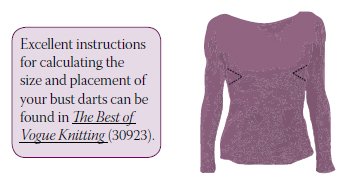
Sometimes a pattern has a perfectly fitted waistline but needs a little help in the chest area. Bust darts can be added at the edge of the garment at the bustline to add some ease to the chest and to prevent the front of the garment from hiking up. The bust dart is a little extra triangle of fabric at the edge of the garment beneath the arm.
Adding a vertical dart
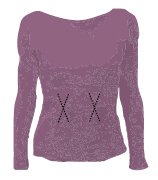
For hourglass figures, you can use vertical darts to make the waist of a sweater more fitted while keeping a slight flare at the hips and bust. A vertical dart is a series of matched decreases on either side of a constant center stitch, followed by a series of matched increases on either side of that same center stitch.
Find your bust points and then plan to place one dart under each point (vertical darts are usually worked in pairs). If you are trying to flatter dramatic curves at the bustline, you may want to place two shallower vertical darts next to each other under each bust point.
How to fix these common problems with simple short rows
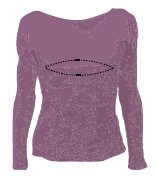 “My sweater stretches and pulls across the bust.”
“My sweater stretches and pulls across the bust.”
If you try to correct a too-tight bust fit by adding extra stitches at the ends of the rows, the extra fabric will bunch under the arms. Instead, add dimension to the bust at the front of the sweater by working a number of short rows across the front of the sweater. These extra short rows will create a sort of “pocket” for the bust, avoiding the extra fabric at the armholes.
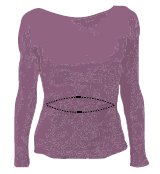 “I need a bit more room in the waistline…”
“I need a bit more room in the waistline…”
This is a case where adding stitches at either end of the row may result in a strange bulge of fabric at the waistline. Short rows would add some ease to the middle of the sweater almost invisibly.
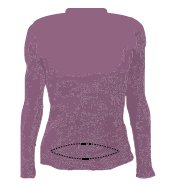 “This wasn’t a pattern for a cropped sweater!”
“This wasn’t a pattern for a cropped sweater!”
If you have a long torso, you can add short rows to the back of your sweater to keep it from riding up.
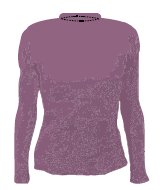 “Isn’t there supposed to be more of a collar in the back?”
“Isn’t there supposed to be more of a collar in the back?”
If the neckline is too low in the back, working a few short rows across the back of the neck can create a nice seamless raised edge.

